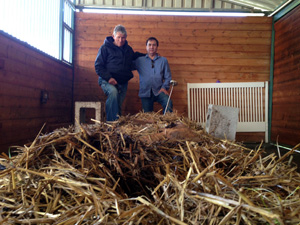The “how it works” of our vermiculture system begins with the red wriggler worm, Eisenia fetida. According to Christophe, each worm is its own compost bin. They have a gizzard that breaks up bacteria, fungi, and protozoa.  The guts of the worms are full of microbes too. Nematodes, protozoa, fungi, and bacteria are all present in each worms body. Worms do secrete enzymes that aid in digestion, but Christophe thinks, similar to humans, that the majority of digestion is done by the flora present in the gut.
The guts of the worms are full of microbes too. Nematodes, protozoa, fungi, and bacteria are all present in each worms body. Worms do secrete enzymes that aid in digestion, but Christophe thinks, similar to humans, that the majority of digestion is done by the flora present in the gut.
Our vermicompost system is a 3-step process. We first start by pre-composting food scraps for the worms in a large outdoor pile. The food that is already partially processed is easier for the worms to break down. By pre-composting we also kill off any potential pathogenic bacteria and weed seeds in the scraps by heating the pile up to 160F. The pile is then cooled down to preserve a diversity of microbial life. The pre-compost is then fed to our worms that live in the Wig Wam and Crocodile Pit.
The Wig Wam is step 2 in our system. The Wig Wam is essentially a giant round barrel that is divided into two parts. The top half is where the worms live and where we add fruit scraps and cardboard for their food. The bottom portion is empty for collection of the compost. A grate divides the two sections. To collect the compost there is a crank on the Wig Wam, which spins a grater (think cheese) around the bin and loosens the compost that falls through the grate into the collection bin. Our Wig Wam is about and produces about 60lbs of finished product a week. How much food does it take to make that much vermicompost? -About 200 lbs. Christophe hopes to get production up to 100 pounds per week in our Wig Wam. Our Wig Wam is fairly small for a farm of our size. They can be up to about 12 foot wide and tall with automated grates for large-scale production of compost.
The third step is the “Crocodile Pit” as our field crew has named it. It is a large rectangle constructed from concrete blocks. The pit is filled with worms and pre-compost. A layer of straw on the top acts as an insulator to keep the worms warm. Christophe transfers worms from the Wig Wam to populate the Crocodile Pit. The pre-composted food scraps are placed in one area of the pit, which draws the worms to eat. When they’ve eaten everything up and composted it, new pre-compost is added to another area of the pit and the worms migrate over to eat. We can then harvest the compost, and back and forth through out the pit the worms go.
And that is our how our wonderful world of worms works!

 Follow
Follow
